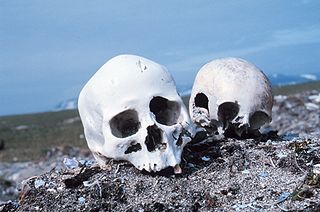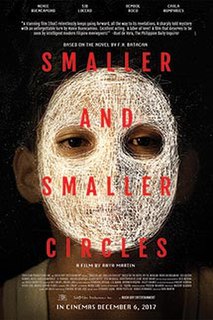Detective fiction is a subgenre of crime fiction and mystery fiction in which an investigator or a detective—either professional, amateur or retired—investigates a crime, often murder. The detective genre began around the same time as speculative fiction and other genre fiction in the mid-nineteenth century and has remained extremely popular, particularly in novels. Some of the most famous heroes of detective fiction include C. Auguste Dupin, Sherlock Holmes, and Hercule Poirot. Juvenile stories featuring The Hardy Boys, Nancy Drew, and The Boxcar Children have also remained in print for several decades.

Forensic science is the application of science to criminal and civil laws, mainly—on the criminal side—during criminal investigation, as governed by the legal standards of admissible evidence and criminal procedure.
A whodunit or whodunnit is a complex, plot-driven variety of the detective story in which the puzzle regarding who committed the crime is the main focus. The reader or viewer is provided with the clues from which the identity of the perpetrator may be deduced before the story provides the revelation itself at its climax. The investigation is usually conducted by an eccentric, amateur, or semi-professional detective. This narrative development has been seen as a form of comedy in which order is restored to a threatened social calm.

Crime fiction is a literary genre that fictionalises crimes, their detection, criminals, and their motives. It is usually distinguished from mainstream fiction and other genres such as historical fiction or science fiction, but the boundaries are indistinct. Crime fiction has multiple subgenres, including detective fiction, courtroom drama, hard-boiled fiction and legal thrillers. Most crime drama focuses on crime investigation and does not feature the court room. Suspense and mystery are key elements that are nearly ubiquitous to the genre.
The "locked-room" or "impossible crime" mystery is a subgenre of detective fiction in which a crime is committed in circumstances under which it was seemingly impossible for the perpetrator to commit the crime or evade detection in the course of getting in and out of the crime scene. The crime in question typically involves a crime scene with no indication as to how the intruder could have entered or left, for example: a locked room. Following other conventions of classic detective fiction, the reader is normally presented with the puzzle and all of the clues, and is encouraged to solve the mystery before the solution is revealed in a dramatic climax.

Mystery fiction is a genre of fiction usually involving a mysterious death or a crime to be solved. Often with a closed circle of suspects, each suspect is usually provided with a credible motive and a reasonable opportunity for committing the crime. The central character will often be a detective who eventually solves the mystery by logical deduction from facts presented to the reader. Sometimes mystery books are nonfictional. "Mystery fiction" can be detective stories in which the emphasis is on the puzzle or suspense element and its logical solution such as a whodunit. Mystery fiction can be contrasted with hardboiled detective stories, which focus on action and gritty realism.
Perfect crime is a colloquial term used in law and fiction to characterize crimes that are undetected, unattributed to an identifiable perpetrator, or otherwise unsolved or unsolvable as a kind of technical achievement on the part of the perpetrator. In certain contexts, the concept of perfect crime is limited to just undetected crimes; if an event is ever identified as a crime, some investigators say it cannot be called "perfect".
A cold case is a crime or an accident that has not yet been fully solved and is not the subject of a recent criminal investigation, but for which new information could emerge from new witness testimony, re-examined archives, new or retained material evidence, as well as fresh activities of the suspect. New technical methods developed after the case can be used on the surviving evidence to analyze the causes, often with conclusive results.
Michael Joseph Kurland is an American author, best known for his works of science fiction and detective fiction. Kurland lives in San Luis Obispo, California.
An inverted detective story, also known as a "howcatchem", is a murder mystery fiction structure in which the commission of the crime is shown or described at the beginning, usually including the identity of the perpetrator. The story then describes the detective's attempt to solve the mystery. There may also be subsidiary puzzles, such as why the crime was committed, and they are explained or resolved during the story. This format is the opposite of the more typical "whodunit", where all of the details of the perpetrator of the crime are not revealed until the story's climax.
Otto Penzler is an editor of mystery fiction in the United States, and proprietor of The Mysterious Bookshop in New York City, where he lives.

Darkly Dreaming Dexter is a 2004 novel by Jeff Lindsay, the first in his series about serial killer Dexter Morgan. It formed the basis of the Showtime television series Dexter and won the 2005 Dilys Award and the 2007 Book to TV award.
Maria Felisa H. Batacan is a Filipino journalist and a writer of crime and mystery fiction. Her work has been published in the Philippines and abroad under the name F.H. Batacan.

The Mystery of a Hansom Cab is a mystery fiction novel by Australian writer Fergus Hume. The book was first published in Australia, in 1886. Set in Melbourne, the story focuses on the investigation of a homicide involving a body discovered in a hansom cab, as well as an exploration into the social class divide in the city. The book was successful in Australia, selling 100,000 copies in the first two print runs. It was then published in Britain and the United States, and went on to sell over 500,000 copies worldwide, outselling the first of Arthur Conan Doyle's Sherlock Holmes novels, A Study in Scarlet (1887).

The Sarah Armstrong Mystery series is a fictional series created by true crime author-turned-novelist Kathryn Casey, first published by St. Martin's Minotaur in 2008. Booklist magazine named the first novel, Singularity, one of the top ten Best Crime Novel Debuts of 2009.
The closed circle of suspects is a common element of detective fiction, and the subgenre that employs it can be referred to as the closed circle mystery. Less precisely, this subgenre - works with the closed circle literary device - is simply known as the "classic", "traditional" or "cozy" detective fiction.
Gong'an or crime-case fiction is a subgenre of Chinese crime fiction involving government magistrates who solve criminal cases. Gong'an fiction was first appeared in the colloquial stories of Song dynasty. Gong'an fiction was then developed and become one of the most popular fiction styles in Ming and Qing dynasties. The Judge Dee and Judge Bao stories are the best known examples of the genre.

Fictional detectives are characters in detective fiction. These characters have long been a staple of detective mystery crime fiction, particularly in detective novels and short stories. Much of early detective fiction was written during the "Golden Age of Detective Fiction" (1920s-1930s). These detectives include amateurs, private investigators and professional policemen. They are often popularized as individual characters rather than parts of the fictional work in which they appear. Stories involving individual detectives are well-suited to dramatic presentation, resulting in many popular theatre, television, and movie characters.











